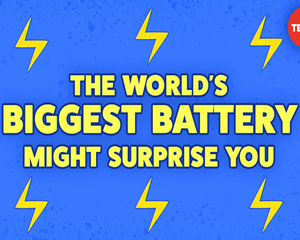As of 2020, the world's biggest lithium-ion battery is hooked up to the Southern California power grid
截至2020年,全球最大的锂离子电池与南加州电网接通,
and can provide 250 million watts of power, or enough to power about 250,000 homes.
能够提供2.5亿瓦特的电力,足够为大约25万家庭供电。
But it's actually not the biggest battery in the world: these lakes are.
但实际上它并不是世界上最大的电池:这些湖泊才是。
Wait -- how can a pair of lakes be a battery?
等一下--两座湖泊怎会是个电池呢?
To answer that question, it helps to define a battery: it's simply something that stores energy and releases it on demand.
了解电池的定义有助于回答这个问题:电池只是个储存能量并应需求而释放能量的东西。
The lithium-ion batteries that power our phones, laptops, and cars are just one type. They store energy in lithium ions.
为我们的手机、笔记本电脑和汽车提供动力的锂离子电池,只是电池的一种类型。它们用锂离子储存能量。
To release the energy, the ions are separated from their electrons, then rejoined at the other end of the battery as a new molecule with lower energy.
为释放能量,锂离子与它们的电子分离,然后在电池的另一头再次结合,成为能量较低的新分子。
How do the two lakes store and release energy? First, one is 300 meters higher than the other.
两座湖泊如何储存和释放能量呢?首先,一座湖比另一座高出300米。
Electricity powers pumps that move billions of liters of water from the lower lake to the higher one.
电力驱动水泵把数十亿升水从低湖转移到高湖。
This stores the energy by giving the water extra gravitational potential energy.
通过为水提供额外的重力势能来储存能量。
Then, when there's high demand for electricity, valves open,
然后,在电力需求量高的时候打开阀门,
releasing the stored energy by letting water flow downhill to power 6 giant turbines that can generate 3 billion watts of power for 10 hours.
让水往山下流从而释放储存的能量,这些能量可为6个巨型的涡轮机提供动力,进而持续10小时,产生30亿瓦的电力。
We're going to need more and more giant batteries.
我们将会需要越来越多巨型电池。
That's because right now, generating enough electricity to power the world produces an unsustainable amount of greenhouse gas: 14 billion tons per year.
那是因为目前供给世界足够电力的发电方式产生的温室气体量不可持续:每年140亿吨。
We'll need to get that number down to net-zero. But many clean energy sources can't produce electricity 24/7.
我们将需要把那个数字降到净零。然而很多清洁能源无法全天候发电。
So to make the switch, we need a way to store the electricity until it's needed.
所以为实现这一转变,我们需要一种能储电直到需要用电的方法。
That means we need grid-scale batteries: batteries big enough to power multiple cities.
这意味着我们需要电网规模的电池:大到足够为多个城市供电的电池。

Unfortunately, neither of the giant batteries we've talked about so far can solve this problem.
不幸的是,我们已经讨论过的两种巨型电池都无法解决这个问题。
The two lakes setup requires specific geography, takes up a lot of land, and has high upfront costs to build.
湖泊电池对地理位置有特定要求,占用大片土地,而且前期的建设成本很高。
The giant lithium-ion battery in California, meanwhile, can power about 250,000 homes, yes, but only for an hour.
与此同时,加州的巨大锂离子电池可以为大约25万家庭供电,没错,但只能供电一小时。
Lithium-ion batteries are great for things that don't use a lot of power. But to store a lot of energy, they have to be huge and heavy.
锂离子电池对于耗电少的东西非常有用。但为了储存大量能量锂电子电池就必须又大又重。
That's why electric planes aren't a thing:
这就是电动飞机仍不成气候的原因:
the best electric plane can only carry two people for about 1,000 kilometers on one charge, or its batteries would be too heavy to fly.
目前最好的电动飞机只能载两个人,充电一次,大约能跑10000公里,要不然电池就重到飞不起来。
A typical commercial jet can carry 300 people over 14,000 km before refueling.
典型的商用飞机能载300人,飞行超过14000公里才需再加油。
Lithium-ion batteries also require certain heavy metals to make. These resources are limited, and mining them often causes environmental damage.
制造锂离子电池还需要若干重金属。这些资源有限,而且开采过程往往会破坏环境。
Inventors all over the world are rising to the challenge of making batteries that can meet our needs -- many of them even weirder than the two lakes.
全世界的发明家奋起面对这一挑战:发明能满足我们的需求的电池。其中,许多电池设计甚至比湖泊电池更奇怪。
One company is building a skyscraper battery. When the sun is shining, a crane powered by solar energy piles blocks on top of each other in a tower.
一家公司正在建造摩天大楼电池。当日光照耀时,太阳能驱动的起重机把一块块的积木相互堆叠于塔中。
At night, the cranes let gravity pull the blocks down and use the resulting power to spin generators.
到了晚上,起重机让重力将积木拉下来,借此产生的能量驱动发电机。
Though there have been some early setbacks, another promising approach involves heating up salts until they melt.
尽管早期遭遇了一些挫折,另一种具有前景的方法是加热盐直到熔化。
The molten salt can be stored until there's a high demand for electricity, then used to boil water.
熔化的盐可保存至电力需求大的时候,然后用来烧水。
The steam can power turbines that generate electricity. Another idea: bio-batteries made from paper, powered by bacteria, and activated by spit.
蒸汽可以驱动涡轮机发电。另一个想法是制造生物电池纸,由细菌提供动力,由唾液激活。
Bacteria release energy in the form of electrons when they metabolize glucose,
细菌代谢葡萄糖时以电子的形态释放能量,
and at least one species of bacteria can transfer those electrons outside its cells, completing a circuit.
而且至少有一种细菌能够把这些电子转移到细胞外,形成完整的电路。
While these batteries won't power a city, or even a house, they don't have the waste and cost concerns of traditional batteries.
尽管这些电池无法为一座城市,甚至一栋房子供电,但它们没有传统电池的废弃和成本顾虑。
From vast mountain lakes to microscopic bacteria,
从巨大的山湖到微小的细菌,
from seawater batteries that bypass the need for heavy metals to nuclear batteries that power deep space missions, we're constantly rethinking what a battery can be.
从无重金属需求的海水电池到为深空任务供能的核电池,我们不断反复思考电池可以是什么样的。
The next unlikely battery could be hiding in plain sight -- just waiting to be discovered and help us achieve a sustainable future.
或许下一个无法想象的电池正隐藏在光天化日之下--就等着被发现,帮助我们实现可持续发展的未来。


